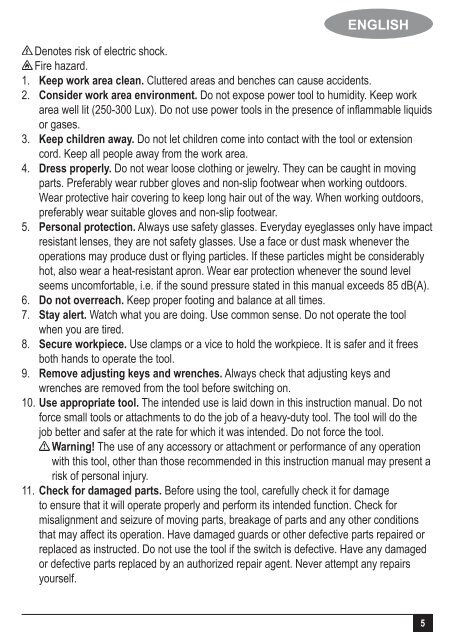BlackandDecker Tournevis- As36ln - Type H1 - Instruction Manual (Asie)
BlackandDecker Tournevis- As36ln - Type H1 - Instruction Manual (Asie)
BlackandDecker Tournevis- As36ln - Type H1 - Instruction Manual (Asie)
You also want an ePaper? Increase the reach of your titles
YUMPU automatically turns print PDFs into web optimized ePapers that Google loves.
ENGLISH<br />
Denotes risk of electric shock.<br />
Fire hazard.<br />
1. Keep work area clean. Cluttered areas and benches can cause accidents.<br />
2. Consider work area environment. Do not expose power tool to humidity. Keep work<br />
area well lit (250-300 Lux). Do not use power tools in the presence of inflammable liquids<br />
or gases.<br />
3. Keep children away. Do not let children come into contact with the tool or extension<br />
cord. Keep all people away from the work area.<br />
4. Dress properly. Do not wear loose clothing or jewelry. They can be caught in moving<br />
parts. Preferably wear rubber gloves and non-slip footwear when working outdoors.<br />
Wear protective hair covering to keep long hair out of the way. When working outdoors,<br />
preferably wear suitable gloves and non-slip footwear.<br />
5. Personal protection. Always use safety glasses. Everyday eyeglasses only have impact<br />
resistant lenses, they are not safety glasses. Use a face or dust mask whenever the<br />
operations may produce dust or flying particles. If these particles might be considerably<br />
hot, also wear a heat-resistant apron. Wear ear protection whenever the sound level<br />
seems uncomfortable, i.e. if the sound pressure stated in this manual exceeds 85 dB(A).<br />
6. Do not overreach. Keep proper footing and balance at all times.<br />
7. Stay alert. Watch what you are doing. Use common sense. Do not operate the tool<br />
when you are tired.<br />
8. Secure workpiece. Use clamps or a vice to hold the workpiece. It is safer and it frees<br />
both hands to operate the tool.<br />
9. Remove adjusting keys and wrenches. Always check that adjusting keys and<br />
wrenches are removed from the tool before switching on.<br />
10. Use appropriate tool. The intended use is laid down in this instruction manual. Do not<br />
force small tools or attachments to do the job of a heavy-duty tool. The tool will do the<br />
job better and safer at the rate for which it was intended. Do not force the tool.<br />
Warning! The use of any accessory or attachment or performance of any operation<br />
with this tool, other than those recommended in this instruction manual may present a<br />
risk of personal injury.<br />
11. Check for damaged parts. Before using the tool, carefully check it for damage<br />
to ensure that it will operate properly and perform its intended function. Check for<br />
misalignment and seizure of moving parts, breakage of parts and any other conditions<br />
that may affect its operation. Have damaged guards or other defective parts repaired or<br />
replaced as instructed. Do not use the tool if the switch is defective. Have any damaged<br />
or defective parts replaced by an authorized repair agent. Never attempt any repairs<br />
yourself.
















